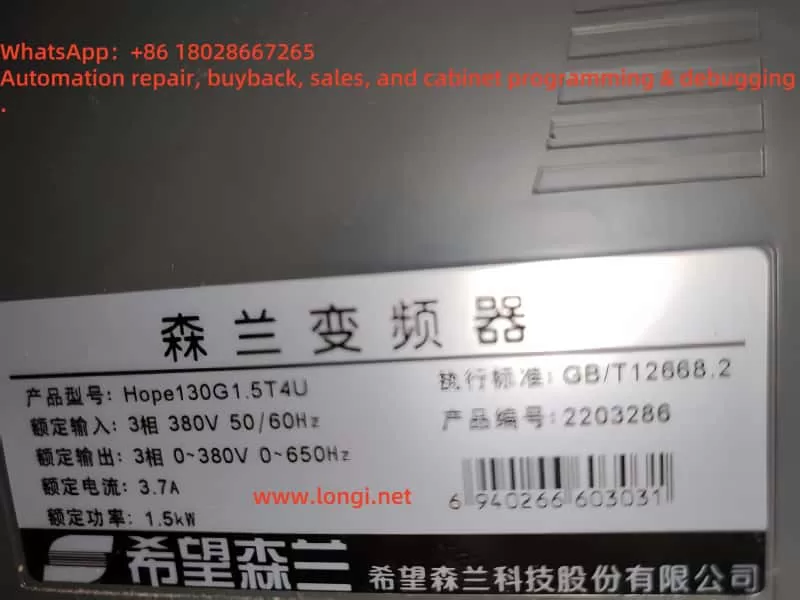Introduction
Variable Frequency Drives (VFDs), such as the Hope-130 series manufactured by Senlan, are critical components in modern industrial automation, enabling precise control of motor speed and energy efficiency. However, like any sophisticated equipment, VFDs are prone to faults that can disrupt operations if not addressed promptly. One such fault is the “Er.OLL” error code, which signals an overcurrent or overload condition. This article delves into the meaning of the Er.OLL fault, its potential causes, diagnostic methods, and step-by-step solutions to restore normal operation. By understanding this fault, operators can minimize downtime and maintain productivity in their facilities.

What Does the Er.OLL Fault Mean?
The “Er.OLL” fault code, as indicated on the Hope-130 VFD display, is an alarm triggered by the device’s protective mechanisms when it detects an overcurrent or overload situation. According to the technical manual for the Hope-130 series (referenced on Page 111), this fault, denoted as code 15, is associated with excessive current draw that exceeds the VFD’s rated capacity. Overcurrent can occur when the motor is subjected to a load beyond its design limits, or when electrical issues such as short circuits or insulation failures are present. The fault is designed to protect the VFD and connected motor from damage, but it requires immediate attention to identify and resolve the underlying issue.
Common Causes of the Er.OLL Fault
Several factors can contribute to the Er.OLL fault, ranging from mechanical to electrical and configuration-related issues. Understanding these causes is the first step toward effective troubleshooting:
- Excessive Mechanical Load: If the motor is driving a machine with an unusually high load—such as a jammed conveyor belt or a pump handling blocked fluid—the current demand may spike, triggering the fault.
- Short Circuit or Ground Fault: Damaged wiring, faulty insulation, or a short circuit between phases can cause an abrupt increase in current, leading to the Er.OLL alarm.
- Incorrect VFD Parameter Settings: Misconfigured parameters, such as an improperly set current limit or acceleration/deceleration time, can cause the VFD to misinterpret normal operation as an overload.
- Motor Issues: A motor with worn bearings, internal short circuits, or phase imbalances can draw excessive current, prompting the fault.
- Power Supply Problems: Voltage fluctuations or an unstable power supply can lead to irregular current flows, potentially triggering the protective mechanism.
Diagnostic Approach
Diagnosing the Er.OLL fault requires a systematic approach to pinpoint the root cause. Here are the steps to follow:
- Visual Inspection: Begin by checking the motor, wiring, and connected machinery for obvious signs of damage, such as burnt cables, loose connections, or mechanical blockages.
- Review VFD Display and Logs: The Hope-130 VFD provides fault details on its display. Use the “MENU” and “ENTER” buttons to access fault history and current readings (e.g., A for amperage) to confirm the overcurrent condition.
- Measure Electrical Parameters: Use a multimeter to check the input voltage and current drawn by the motor. Compare these values against the VFD’s rated specifications.
- Inspect Motor Operation: Run the motor manually (if safe) to listen for unusual noises or vibrations that might indicate mechanical issues.
- Check Parameter Settings: Access the VFD’s parameter menu to verify settings such as current limit, overload protection thresholds, and acceleration profiles.
Step-by-Step Solutions
Once the cause is identified, the following solutions can be applied to resolve the Er.OLL fault:
- Address Mechanical Overload:
- If a mechanical blockage is found (e.g., a jammed conveyor), stop the system, clear the obstruction, and restart the VFD.
- Ensure the load matches the motor’s rated capacity. If the load is consistently high, consider upgrading to a more powerful motor or VFD.
- Fix Electrical Faults:
- Inspect all wiring for signs of damage or short circuits. Replace any faulty cables or connectors.
- Test for ground faults using an insulation resistance tester. Repair or replace any components with compromised insulation.
- Adjust VFD Parameters:
- Access the VFD’s parameter settings via the control panel. Increase the acceleration/deceleration time to reduce the current spike during startup.
- Adjust the current limit parameter to align with the motor’s rated current, ensuring it does not exceed the VFD’s capacity.
- Service the Motor:
- If the motor is faulty, disassemble it to check for worn bearings or internal short circuits. Lubricate or replace bearings as needed, and rewind or replace the motor if damage is extensive.
- Balance the motor phases by checking the resistance of each winding with a multimeter.
- Stabilize Power Supply:
- Install a voltage stabilizer or UPS if power fluctuations are detected. Ensure the power source meets the VFD’s voltage requirements.
After implementing these fixes, reset the fault by pressing the “RESET” button on the VFD panel and attempt to restart the system. Monitor the operation to ensure the fault does not recur.

Preventive Measures
To avoid future Er.OLL faults, consider the following preventive strategies:
- Regular Maintenance: Schedule routine inspections of the VFD, motor, and connected machinery to detect wear or damage early.
- Proper Installation: Ensure the VFD and motor are installed according to the manufacturer’s guidelines, with adequate ventilation and secure wiring.
- Training: Train operators to recognize early signs of overload or electrical issues and to use the VFD’s diagnostic features effectively.
- Load Management: Avoid sudden load changes by implementing gradual startup procedures and ensuring machinery operates within design limits.
Conclusion
The Er.OLL fault in a Hope-130 VFD is a critical alert that demands prompt action to protect equipment and maintain operational efficiency. By understanding its meaning as an overcurrent or overload condition and systematically diagnosing its causes—whether mechanical, electrical, or configurational—operators can apply targeted solutions to resolve the issue. From clearing mechanical blockages to adjusting VFD parameters and servicing the motor, each step contributes to a robust resolution process. Moreover, adopting preventive measures can significantly reduce the likelihood of recurrence, ensuring long-term reliability. With proper care and attention, the Hope-130 VFD can continue to serve as a dependable asset in industrial applications, minimizing downtime and maximizing productivity.
